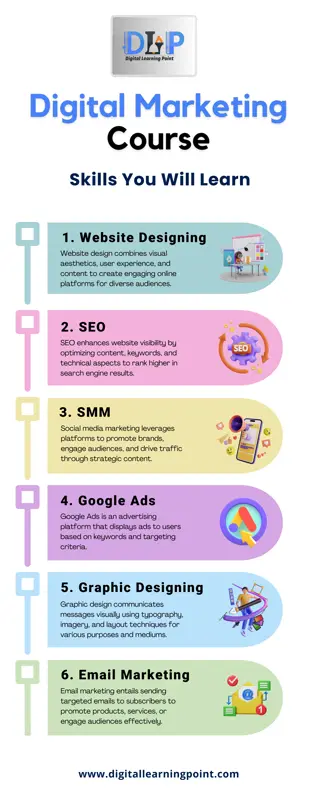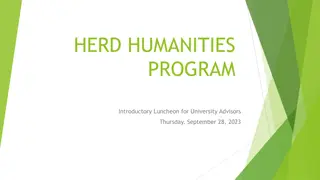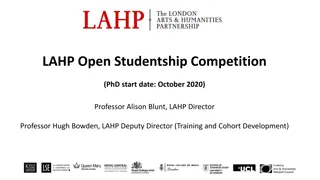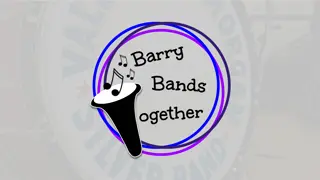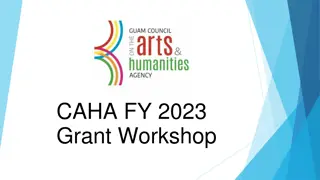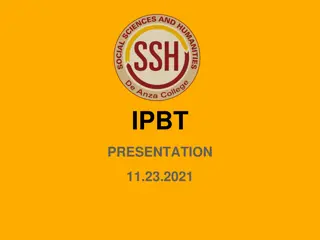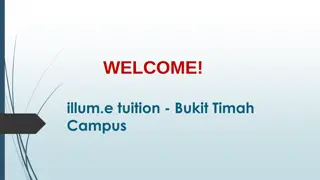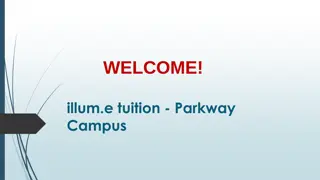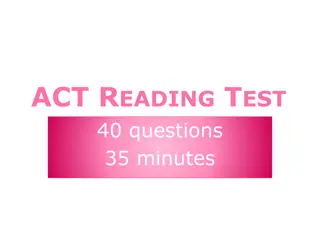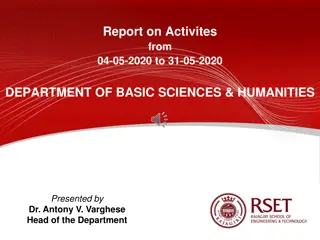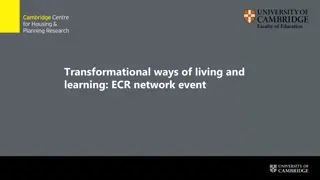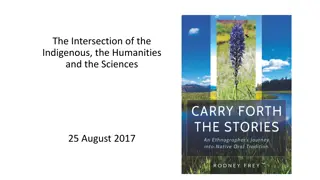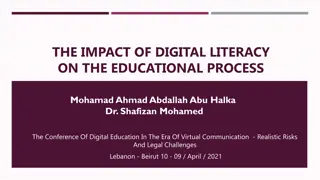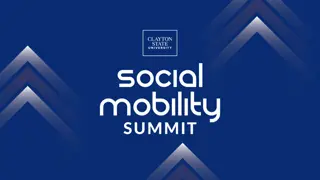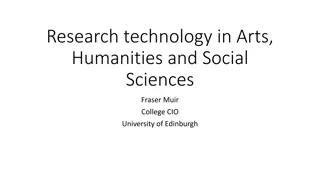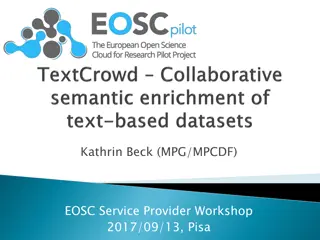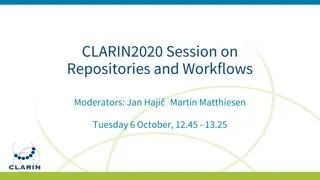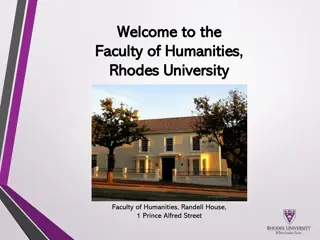The Importance of Digital Text Documentation in the Humanities
Approach digital text as documentation in the digital humanities is essential for its materialization and interaction. Digital technologies allow text to be easily manipulated and shared across platforms, highlighting the need for proper documentation. This documentation determines how text is presented and engaged with, shaping the practices of reading, writing, and more. A complex material assemblage surrounds digital documents, emphasizing the interconnectedness of hardware, software, and content. The Tripartite Model of Digital Documentation views digital documents as conceptual, physical, and logical objects, each playing a crucial role in their existence and utility.
Download Presentation

Please find below an Image/Link to download the presentation.
The content on the website is provided AS IS for your information and personal use only. It may not be sold, licensed, or shared on other websites without obtaining consent from the author. Download presentation by click this link. If you encounter any issues during the download, it is possible that the publisher has removed the file from their server.
E N D
Presentation Transcript
Digital Text's Documentation: Approaching Text as Documentation within the Digital Humanities Dr. Marc Kosciejew / University of Malta Twenty-first International Conference on New Directions in the Humanities Sorbonne Universit , Paris, France June 2023
A seeming indifference towards documentation is exacerbated by digital technologies. When text can be easily created, edited, remixed, repurposed, and shared on multiple platforms and instantly emerge (simultaneously) across different screens, it appears unanchored or untethered to material constraints.
But documentation is necessary for the emergence of text into material instantiations that can be interacted with, engaged, and used. It determines the kinds, forms, and formats of text that can be inscribed into or displayed on a specific medium that, in turn, shapes the affordances of and practices with that text, including reading, writing, annotating, commenting, viewing, or hearing.
There is a complex material assemblage surrounding and making possible digital documents. Specifically, a digital document whether wiki or e-book, website or podcast, virtual reality environment or social media status update is a discrete unit of bits, requiring a surrounding and supporting infrastructure of software and hardware, which cannot be separated from the digital technologies, programs, and devices upon which it depends. It cannot be held in one s hands as its own thing without its associated hardware and software infrastructure. It is not a discrete or separate object that is relatively independent of its surroundings, unlike most of its print and physical counterparts.
A Tripartite Model of Digital Documentation A Tripartite Model of Digital Documentation A digital document, in this model, can be approached simultaneously as a conjoined: Conceptual object (the display and afforded practices, such as reading and viewing, undertaken by the users) Physical object (data inscribed on a medium) Logical object (their recognition and processing by software, programs, platforms, etc.).
1. The conceptual object. This layer is the main and most recognized way in which individuals understand and engage in practices with digital documents. It is at this layer that individuals see, read, write, view, and otherwise interact with digital text. It is the digital document displayed on a screen or monitor
2. The physical object It is at this layer that users tangibly hold, touch, and otherwise physically interact with the digital document insofar as its particular device, computer, or machine is concerned. It is the layer of the screen/interface, device, physical components, hardware, wires, and so on. Digital texts are inscriptions on the physical medium of the device, computers, or machine, which are established by electronic signals indicating an on or off state.
3. The logical object It is the under-the-hood parts of the digital document, involving the software and systems required to constitute and display the digital document as a conceptual object that one sees, reads, writes, and uses. Specifically, this layer involves the applications software involved in constituting the digital document, such as the data and word processing software, multimedia programs, and database applications, which are, in turn, controlled and operated by the system software including operating systems, utilities, compilers, etc.
Parallels between digital and analogue documents collapse at the logical layer of abstraction. A print document s form, format, text, and wholeness are embodied and manifest in the physical inscription on a medium. The print document in its entirety that is, as a whole, discrete, finite, tangible object can be seen, held, and used, whilst the contours, let alone the presence, of its digital counterpart cannot be determined simply by looking at its physical medium alone. But in the digital environment, the physical inscription of bits on digital media cannot reliably indicate what, if any, documents are written on those media.
The digital document cannot exist at only one or two layers. All three layers are required for it to be constituted, maintained, managed, stored, displayed, and used. If one or more layers malfunction or become compromised in some way, the integrity, and possible survival, of the digital document would be jeopardized.
3 Data Types 3 Data Types Encoding of digital text into a digital document, moreover, requires three different data types to comprise the document. A. Content data constitutes the document s content. B. Form data determines the organization of the content into an ordered structure enabling the system to establish it in the correct documentary form. C. Composition data informs the system what content data and form data belong to which document.
There are two different kinds of digital text at work in this relationship: the digital text of the intellectual content (conceptual layer) and the digital text of instructional data/codes (logical layer). On the one hand, the digital document at the conceptual layer shows the digital text as the user imagines, expects, and needs it to be in terms of intellectual content. On the other hand, the digital document at the logical layer involves different kinds of digital text (data and codes) that instructs the conceptual layer how to manifest the intended intellectual content.
Digital encoding at this logical layer, in other words, enables a device, computer, or machine to produce/reproduce the intended manifestation, but it does not have the same form and will not have the same content as the manifested document. Different kinds of software and systems can encode the digital document in divergent fashions whilst retaining the same manifestation at the conceptual layer. Although it is the same digital document, the form in which it manifests to a user is different to the form in which it is encoded digitally.
This difference in form at the conceptual and logical layers is fundamental in two respects. 1. This difference distinguishes a digital document from a print document since the latter is exactly what is inscribed on the physical medium in the way it is inscribed. 2. This difference necessitates the description of the exact nature of a document and to determine whether it continues to exist across changes in the way it is inscribed on a digital medium.
These two layers of abstraction is necessary for helping ensure that a document preserves its identity in regards to its form and different levels of text when migrated across technologies, such as from magnetic to optical discs, and translated into different versions, such as from Word document to Pdf document to an HTML website.
This model shows the extent to which digital text exists in and as digital documents. The virtual world of the digital humanities, and its respective texts and documentation, is indeed a material world.
Kosciejew, Marc. (2021). The Crystal Goblet Revisited: Approaching Text as Documentation within the Digital Humanities . Digital Scholarship in the Humanities, 36 (4): 934-949. https://academic.oup.com/dsh/article-abstract/36/4/934/6132126




